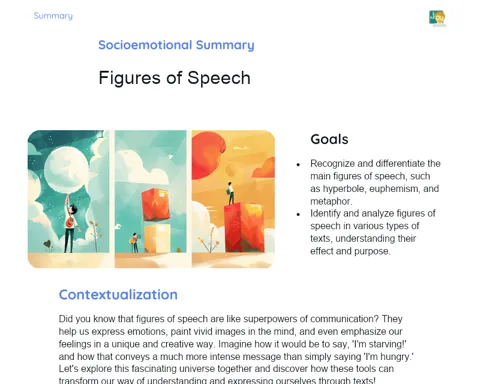INTRODUCTION
Relevance of the Theme
Writing is a vital skill in communication and expression of ideas, thoughts, and feelings. In school life, it is the foundation for learning in all areas of knowledge. Understanding and mastering shared writing, where we build texts with the help of colleagues and teachers, and autonomous writing, which is our ability to write individually, are crucial steps. This theme gains special importance in the 4th year of Elementary School, as it is a phase of transition to greater student independence.
Contextualization
In the literacy journey, students have already started reading and writing. Now is the time to enhance these skills and face new challenges. In a broader context, shared and autonomous writing allows students not only to passively absorb information but also to become active creators of knowledge. This is an essential part of the Portuguese curriculum, which aims to develop fluency and confidence in written communication. By mastering these forms of writing, students will be better prepared for all subjects and also for broader social interactions.### THEORETICAL DEVELOPMENT
Components
-
Shared Writing:
- In shared writing, a text is created with the collaboration of the whole class.
- The teacher acts as the main writer and students offer ideas and suggestions.
- Importance: encourages active participation, teamwork, and appreciation of everyone's ideas.
- Characteristics: dialogic, interactive, and built step by step with the group.
- Contribution: helps to understand how a text is structured and how words are used in a communicative context.
-
Autonomous Writing:
- Refers to the student's ability to write on their own.
- Develops from constant practice and experience with shared writing.
- Importance: allows individual expression and creativity development.
- Characteristics: personal, original, and a reflection of the student's linguistic repertoire.
- Contribution: fosters independence, confidence in one's writing ability, and recognition of their personal style.
Key Terms
-
Writing Fluency:
- Ability to write clearly and with appropriate rhythm.
- Developed through frequent writing activities and revision.
-
Spelling:
- Representation of words through writing.
- Challenge in Portuguese due to phoneme-grapheme irregularities.
- Special attention to words with irregular spelling and frequent use.
-
Phoneme-Grapheme:
- Relationship between the sound (phoneme) and the letter or group of letters (grapheme) that represent it.
- There is not always a direct correspondence, which can cause confusion.
- Important to understand the spelling of words.
Examples and Cases
-
Creating a Text Together:
- Class decides to write a story about a class hero.
- The teacher starts the story by writing the first sentence on the board.
- Each student contributes an idea to continue the narrative.
- The result is a rich text, built with everyone's ideas.
- Theory behind it: each contribution is evaluated and adjusted by the group, teaching about textual coherence and vocabulary.
-
Personal Diary:
- Students keep a diary for autonomous writing practice.
- They write about daily life, feelings, and important events.
- Free structure to encourage individual expression.
- Theory behind it: writing regularly helps to memorize the spelling of words, explore different ways of expressing oneself, and build texts independently.
-
Irregular Words:
- Words like 'exceção' (exception), 'enxergar' (to see), and 'jeito' (way) present spelling challenges.
- Activities like crosswords and memory games can be used to practice these words.
- Theory behind it: repetition and use in various contexts help to fix the correct spelling and understand their irregularities.### DETAILED SUMMARY
Key Points
-
Interactivity in Shared Writing:
- Practice of building texts in a group under the teacher's guidance.
- Reinforces the idea that texts are made up of various ideas that together form a whole.
-
Independence in Autonomous Writing:
- Development of the ability to write individually.
- Stimulates personal expression and confidence.
-
Knowledge of Irregular Spelling:
- Learning the correct way to write words with phonemes that do not directly correspond to graphemes.
- Memorization of common words that often lead to writing errors.
-
Phoneme-Grapheme Relationship:
- Understanding that not all sounds correspond exactly to a letter or group of letters.
- Recognition of the importance of this concept for correct writing.
Conclusions
-
Shared Writing Improves Communication:
- Building texts together helps to understand the importance of effective communication.
-
Autonomous Writing Cultivates Individual Style:
- Through the practice of writing alone, we discover our unique way of expressing ideas.
-
Spelling Memorization:
- Through constant practice and revision, we solidify the correct spelling of words that deviate from common rules.
Exercises
-
Word Puzzle:
- Create a puzzle with words of irregular spelling.
- Cut out the syllables and mix them up.
- Challenge students to correctly assemble the words.
-
Group Story:
- Form small groups and start a story.
- Each student adds a sentence, paying special attention to words with irregular spelling.
- After completing, each group reads their story to the class.
-
Orthographic Treasure Hunt:
- Prepare a treasure hunt where the clues include words with irregular spelling.
- Children must write the word correctly to get the next clue.
- The treasure can be a 'Spelling Detective' certificate for the students.
These exercises help reinforce the correct spelling of words that are often written incorrectly, while encouraging shared and autonomous writing.



